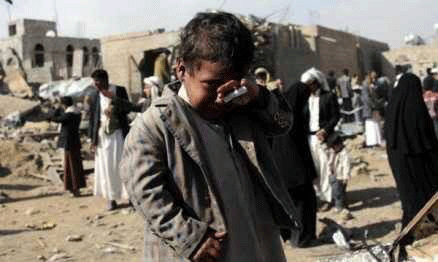
By Adrienne Mahsa Varkiani
On Sunday, April 10, a ceasefire took effect in Yemen, temporarily pausing a deadly conflict that has plagued the country for the past year - one the United States has played an active role in helping to prolong.
Since the Saudi-led coalition started bombarding Yemen in March 2015, nearly 6,500 people have been killed and over 30,000 have been injured. 2.4 million Yemenis are currently displaced inside the country. The coalition’s constant bombing and enforced blockade has led to widespread famine and mass starvation in Yemen, making at least half of all Yemenis food insecure, according to the UN Food and Agriculture Organization.
Despite all these horrors, the United States has continued to provide aid to the Saudi-led coalition.
Last week, Human Rights Watch confirmed that bombs made in the United States were used in one of the conflict’s deadliest attacks, thus far. The March 15, 2016 attack on a busy market in Mastaba, in the northwest of the country, killed at least ninety-seven people, including twenty-five children. According to Human Rights Watch investigations, there were "remnants at the market of a GBU-31 satellite-guided bomb, which consists of a US-supplied MK-84 2,000-pound bomb mated with a JDAM satellite guidance kit, also US-supplied." As Human Rights reported, photos and footage gathered by journalists from British news channel ITV also confirmed "remnants of an MK-84 bomb paired with a Paveway laser guidance kit."
"One of the deadliest strikes against civilians in Yemen’s year-long war involved US-supplied weapons, illustrating tragically why countries should stop selling arms to Saudi Arabia," Priyanka Motaparthy, a researcher at the emergency division at Human Rights Watch, said. "The US and other coalition allies should send a clear message to Saudi Arabia that they want no part in unlawful killings of civilians."
But U.S. involvement in the Yemen conflict is not just limited to U.S.-made weapons. Last month, U.S. National Security Council Spokesperson Bernadette Meehan announced in a statement that "President Obama has authorized the provision of logistical and intelligence support to GCC [Gulf Cooperation Council]-led military operations. While U.S. forces are not taking direct military action in Yemen in support of this effort, we are establishing a Joint Planning Cell with Saudi Arabia to coordinate U.S. military and intelligence support."
Meehan did not clarify exactly what this "support" entails. Nor do we know the reasons why the United States has chosen to involve itself in the Yemen conflict in the first place. As Micah Zenko, a Senior Fellow at the Council on Foreign Relations, has noted, the United States has justified its involvement in the conflict based on drastically different - and at times contradictory - reasons. These include helping the Saudi-led coalition to prove its commitment to Saudi Arabia, fighting Al Qaeda, persuading GCC countries to accept the Iranian nuclear deal, slowing the spread of Iran’s influence in the region, creating a peaceful transition to bring the Yemeni government back to power, and perhaps, most preposterously of all, protecting the Yemeni people.
Much may be unclear about U.S. involvement in the Yemen conflict, but one thing is obvious: the United States has a lot of blood on its hands.
Source: Muftah, Edited by Website Team